How to Cut Chicken Breast: A Step-by-Step Guide
This post may contain affiliate links (disclosure).
Cutting chicken breast correctly is an essential skill that can greatly enhance your cooking. Whether you’re preparing a quick stir-fry, a healthy salad, or a flavorful casserole, having evenly cut pieces of chicken ensures that your dish cooks evenly and tastes delicious. By learning how to cut chicken breasts yourself, you can save money, control the size of your pieces, and ensure maximum freshness. This step-by-step guide will walk you through the process, making it easy and efficient for any home cook to master. Say goodbye to the extra cost of pre-cut chicken and hello to perfectly prepared poultry in your kitchen!
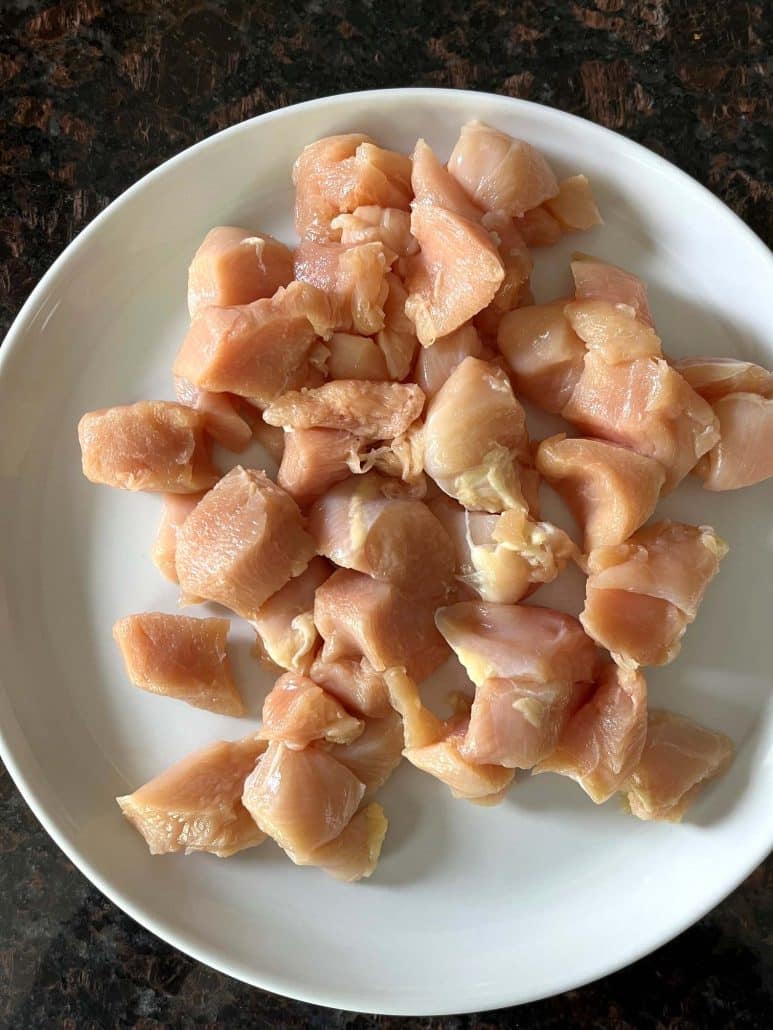
Want to save this recipe?
Materials Needed
Tools and Ingredients:
- Chicken Breasts: Fresh, boneless, and skinless chicken breasts are ideal.
- Disposable Gloves (Optional): Recommended for hygienic handling. You can purchase a pack of 500 disposable gloves from Amazon for less than $10.
- Cutting Board: A sturdy, non-slip cutting board to provide a safe surface for cutting.
- Sharp Knife: A well-maintained, sharp knife to make clean and precise cuts.
Step-by-Step Instructions
Preparation:
- Glove Up (Optional): Put on disposable gloves for hygienic handling of the chicken breast. This step is optional but recommended to prevent cross-contamination and maintain cleanliness.
- Set Up Your Workspace: Place a sturdy, non-slip cutting board on a stable surface. Ensure you have a sharp knife ready.
Cutting the Chicken Breast:
- Place the Chicken Breast: Lay the chicken breast flat on the cutting board. Make sure it is stable and not slipping.
Cutting into Strips:
- Hold and Slice: Hold the chicken breast firmly with one hand. With the knife in your other hand, start slicing the chicken lengthwise into long strips. Ensure that the slices are even in thickness for uniform cooking.
- Adjust Thickness: If you prefer thicker or thinner strips, adjust the width of each slice accordingly.
Cutting into Cubes:
- Turn the Strips: Once you have your strips, turn them 90 degrees on the cutting board.
- Slice into Cubes: Hold the strips together and start slicing them horizontally into small, cube-like pieces. Ensure that the cubes are even in size for consistent cooking.
Repeat:
- Process Additional Chicken Breasts: Repeat the above steps with any additional chicken breasts you need to cut. Follow the same procedure to ensure uniformity in all pieces.
By following these steps, you’ll have perfectly cut chicken pieces ready for your favorite recipes.
Tips and Tricks
Make the Process Easier and Safer:
- Use a Sharp Knife: A sharp knife reduces the risk of slipping and makes cutting smoother and more precise. Regularly sharpen your knife to maintain its edge.
- Partially Freeze the Chicken: If you find the chicken too slippery, partially freezing it for about 15-20 minutes can make it firmer and easier to cut.
- Keep Your Cutting Board Stable: Place a damp cloth or paper towel under your cutting board to prevent it from sliding around while you cut.
- Cut Against the Grain: For more tender pieces of chicken, cut against the grain. This means slicing perpendicular to the muscle fibers.
Hygiene and Safety:
- Wash Hands and Surfaces: Always wash your hands thoroughly before and after handling raw chicken. Clean your cutting board, knife, and any surfaces the chicken has touched with hot, soapy water.
- Separate Raw Chicken from Other Foods: Use a separate cutting board and knife for raw chicken to avoid cross-contamination with other ingredients.
- Proper Storage: If you’re not using the chicken immediately, store the cut pieces in an airtight container in the refrigerator. Use them within 1-2 days or freeze for longer storage.
Efficient Cutting:
- Uniform Pieces: Try to keep the pieces uniform in size, especially if they’re going into the same dish. This ensures even cooking and better texture.
- Batch Cutting: If you regularly use chicken in your meals, consider cutting several breasts at once and freezing the pieces in portions. This saves time for future cooking.
- Use the Right Knife: A boning knife or a chef’s knife works best for cutting chicken breast. These knives offer better control and ease of use.
Common Mistakes to Avoid:
- Using a Dull Knife: A dull knife can crush the chicken and make cutting difficult, increasing the risk of injury.
- Cutting Without a Stable Board: An unstable cutting board can cause accidents. Always ensure your cutting board is secure.
- Overhandling the Chicken: Handle the chicken as little as possible to avoid spreading bacteria around your kitchen.
By following these tips and tricks, you can make the process of cutting chicken breast safer, easier, and more efficient.
Benefits of Cutting Chicken Breast Yourself
Cost Savings
- Economical: Purchasing whole chicken breasts is often cheaper than buying pre-cut pieces. By cutting the chicken yourself, you can save money on your grocery bill.
- Avoid Premium Prices: Pre-cut chicken breasts come at a premium price due to the convenience they offer. By doing it yourself, you avoid paying extra for this convenience.
Freshness and Quality Control
- Maximum Freshness: Cutting the chicken breast yourself ensures that the pieces are as fresh as possible. You can use the chicken immediately after cutting, maintaining its freshness and quality.
- Control Over Piece Size: You have complete control over the size and shape of the pieces. Whether you need thin strips for a stir-fry or small cubes for a salad, you can cut the chicken to your exact specifications.
Reducing Waste
- Less Waste: By cutting chicken breasts yourself, you can minimize waste. You can utilize every part of the chicken breast, unlike pre-cut packages that might include pieces you don’t need.
- Customized Portions: You can cut the chicken into portions that suit your cooking needs, reducing the likelihood of leftovers that might go to waste.
Improved Cooking Results
- Even Cooking: Uniformly cut pieces of chicken to ensure even cooking. This means no more undercooked or overcooked pieces in your dishes, resulting in better texture and flavor.
- Enhanced Presentation: Neatly cut chicken pieces can improve the presentation of your dishes, making them look more appetizing and professional.
Skill Development
- Enhance Your Cooking Skills: Learning to cut chicken breast properly is a valuable cooking skill. It enhances your kitchen capabilities and makes meal preparation more efficient.
- Confidence in the Kitchen: Mastering basic techniques like cutting chicken breast boosts your confidence and makes you more self-reliant in the kitchen.
Flexibility
- Versatility: By cutting the chicken yourself, you can prepare it in various ways to suit different recipes. Whether you need strips, cubes, or thin slices, you have the flexibility to cut the chicken to match any dish.
- Preparation for Various Recipes: Having pre-cut chicken on hand can speed up the cooking process for various recipes, making meal preparation quicker and more convenient.
By cutting chicken breast yourself, you gain numerous benefits that enhance your cooking experience, save money, and ensure the quality and freshness of your meals.
Related Recipes and Uses
Stir-Fries
- Chicken and Vegetable Stir-Fry: Quick and easy, this dish features tender chicken pieces with a medley of colorful vegetables, all tossed in a savory sauce. Perfect for weeknight dinners.
- Hibachi Chicken: Experience the rich flavors of Japan with our easy hibachi chicken recipe, perfect for recreating restaurant-quality grilled chicken at home.
Salads
- Chicken Avocado Salad: Enjoy a refreshing chicken avocado salad, combining tender chicken breast, creamy avocado, and crisp vegetables tossed in a zesty dressing for a satisfying and nutritious meal.
- Chicken Pasta Salad: A refreshing chicken pasta salad combining tender chicken, al dente pasta, crisp vegetables, and a zesty dressing for a delicious and satisfying meal.
Skewers
- Chicken Kebabs: Marinate chicken cubes in your favorite seasoning or sauce, then skewer and grill them with vegetables like bell peppers and onions for a tasty outdoor meal.
- Teriyaki Chicken: Marinate chicken pieces in teriyaki sauce, then cook them for a sweet and savory dish.
Casseroles
- Chicken and Rice Casserole: Combine cubed chicken breast with rice, vegetables and sauce, then bake for a comforting one-dish meal.
- Chicken and Broccoli Fried Rice: Mix chicken with broccoli, and enjoy this yummy chicken broccoli fried rice for a delicious and family-friendly dinner.
Soups and Stews
- Chicken Noodle Soup: Use cubed chicken breast in this classic soup with noodles, carrots, celery, and a flavorful broth for a comforting and nourishing meal.
- Crockpot Chicken Stew: Slow cook chicken and onion for a mouthwatering tender stew.
Tacos and Wraps
- Chicken Tacos: Season chicken strips with taco seasoning, then cook and serve in soft or hard taco shells with your favorite toppings like lettuce, cheese, and salsa.
- Chicken Wraps: Use grilled chicken strips in a wrap with fresh veggies and a tasty sauce for a quick and easy lunch.
Pasta Dishes
- Chicken Alfredo: Combine chicken strips with fettuccine pasta and a rich Alfredo sauce for a decadent and satisfying meal.
- Chicken Pesto Pasta: Toss chicken cubes with pasta and a fresh pesto sauce for a light and flavorful dish.
These recipes showcase the versatility of chicken breast and offer a variety of delicious ways to use your freshly cut pieces. Whether you’re preparing a quick stir-fry, a hearty casserole, or a fresh salad, having pre-cut chicken on hand makes meal preparation a breeze.
FAQs
How thick should the strips be?
The thickness of the strips depends on your recipe and personal preference. For stir-fries, aim for strips that are about 1/2 inch thick to ensure quick and even cooking. For other dishes like salads or wraps, you might prefer thinner or thicker strips.
How do I avoid contamination?
To avoid contamination, always wash your hands, cutting board, knife, and any surfaces that come into contact with raw chicken thoroughly with hot, soapy water. Using disposable gloves can also help maintain hygiene. Additionally, never use the same cutting board for raw chicken and other foods unless it has been properly cleaned.
Can I freeze-cut chicken breast?
Yes, you can freeze-cut chicken breast. Place the cut pieces in an airtight container or a freezer-safe bag, removing as much air as possible. Label the container with the date and use the chicken within 2-3 months for the best quality. Thaw the chicken in the refrigerator before using it.
How do I keep the cutting board from slipping?
To prevent your cutting board from slipping, place a damp cloth or paper towel underneath it. This will help keep the board stable while you cut the chicken.
Want to save this recipe?
Should I cut the chicken with or against the grain?
For more tender pieces, it is best to cut the chicken against the grain. This means slicing perpendicular to the direction of the muscle fibers, which helps break down the muscle tissue and makes the chicken easier to chew.
How can I tell if the chicken breast is fresh?
Fresh chicken breast should have a light pink color, a firm texture, and a mild smell. Avoid chicken that appears grayish, feels slimy, or has a strong, unpleasant odor, as these are signs of spoilage.
What knife is best for cutting chicken breast?
A sharp chef’s knife or a boning knife works best for cutting chicken breast. These knives provide better control and make it easier to cut through the chicken smoothly.
Can I use this method for other types of poultry?
Yes, this method can be applied to other types of poultry such as turkey or duck breast. The key steps remain the same: ensuring the meat is stable, using a sharp knife, and cutting evenly.
What is the best way to store cut chicken in the fridge?
Store cut chicken in an airtight container or a resealable plastic bag in the refrigerator. Make sure the container is well-sealed to prevent any leakage or contamination. Use the chicken within 1-2 days for the best quality and safety.
How do I ensure even cooking with cut chicken pieces?
To ensure even cooking, try to cut the chicken pieces as uniformly as possible. Pieces of similar size will cook at the same rate, preventing some from being overcooked while others are undercooked. Stirring or flipping the pieces regularly while cooking can also help achieve even cooking.
Looking for additional cooking tips?
Blanching Green Beans Guide: Learn the simple process of blanching green beans to maintain their vibrant color and crisp texture.
Cooking Canned Corn Tips: Discover the best methods for cooking canned corn to enhance its flavor and texture.
Making Jello from a Box Instructions: Follow easy steps to make perfect jello from a box mix for a classic, refreshing dessert.
Microwave Egg in Ramen Recipe: Quickly cook an egg in your ramen using the microwave for a delicious and easy meal.
Microwave Pasta Cooking Method: Master the technique of cooking pasta in the microwave for a convenient and fast meal solution.
Grilling Hot Dogs Techniques: Get tips on how to perfectly grill hot dogs for a classic, tasty cookout favorite.
Stovetop Asparagus Sauté Recipe: Learn how to sauté asparagus in a skillet on the stove for a quick and healthy side dish.
How to Cut Chicken Breast into Pieces
Want to save this recipe?
Recipe Video
Ingredients
- Chicken breasts
Recommended Kitchen Tools (click the links below to see the items used to make this recipe)
- 1 Disposable gloves optional but recommended
- 1 Sharp knife
Instructions
- Preparation: Optional: Put on disposable gloves to handle the chicken breast. These can be purchased in packs of 500 from Amazon for less than $10 and can be thrown away after use.
- Cutting the Chicken Breast: Place the chicken breast on the cutting board.
- Cutting into Strips: First, cut the chicken breast into strips. Hold the chicken firmly and slice through it lengthwise to create long strips. If you need chicken strips, you can stop here.
- Cutting into Cubes: To cut the strips into cubes, turn the strips 90 degrees on the cutting board. Slice the strips horizontally into small, cube-like pieces. This is perfect for dishes like stir-fries.
- Repeat: Repeat the process with any additional chicken breasts.
Notes
See also:








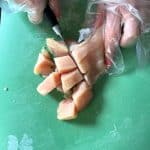
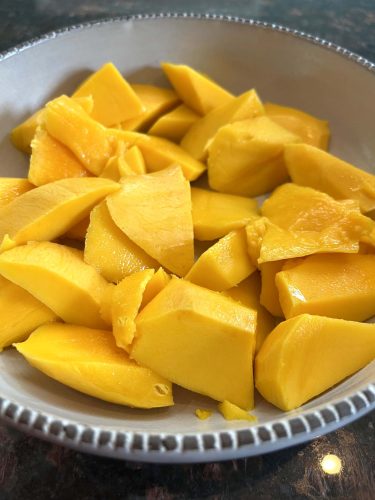


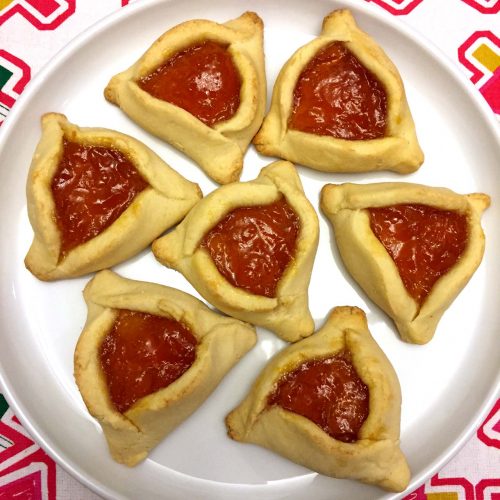

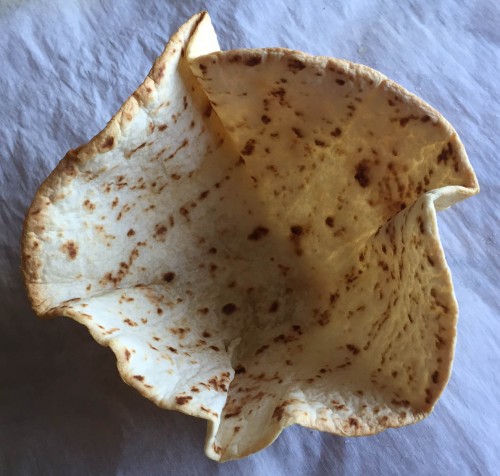
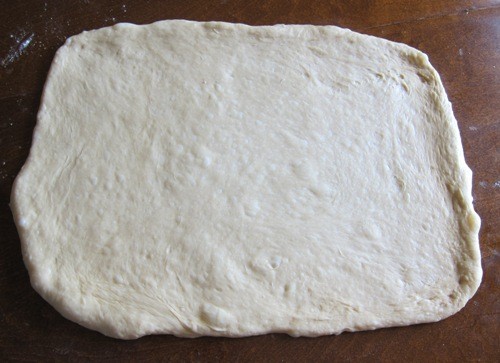
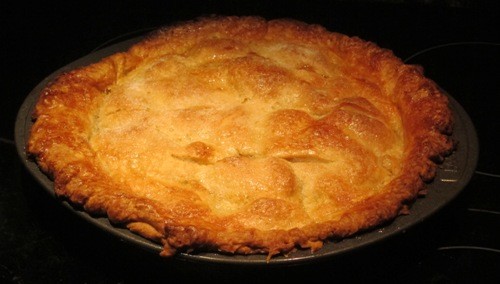
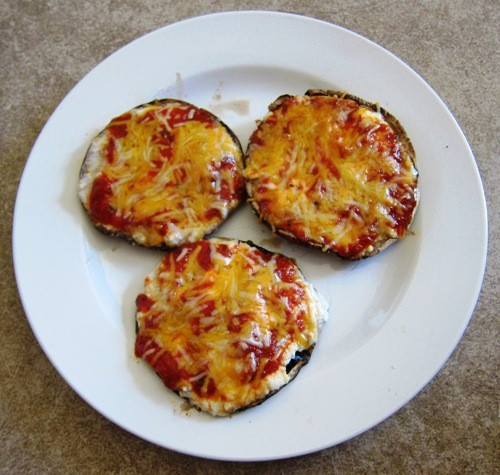
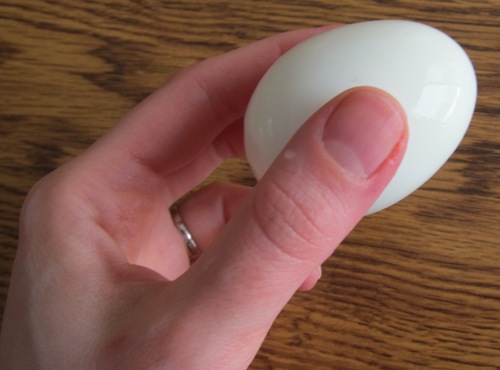
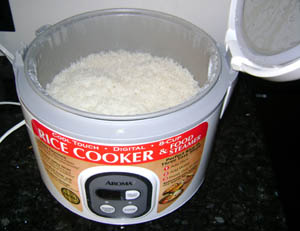
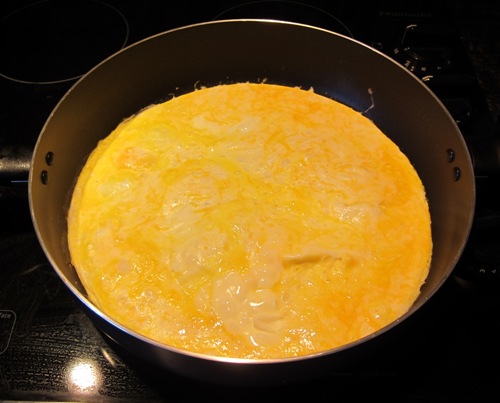
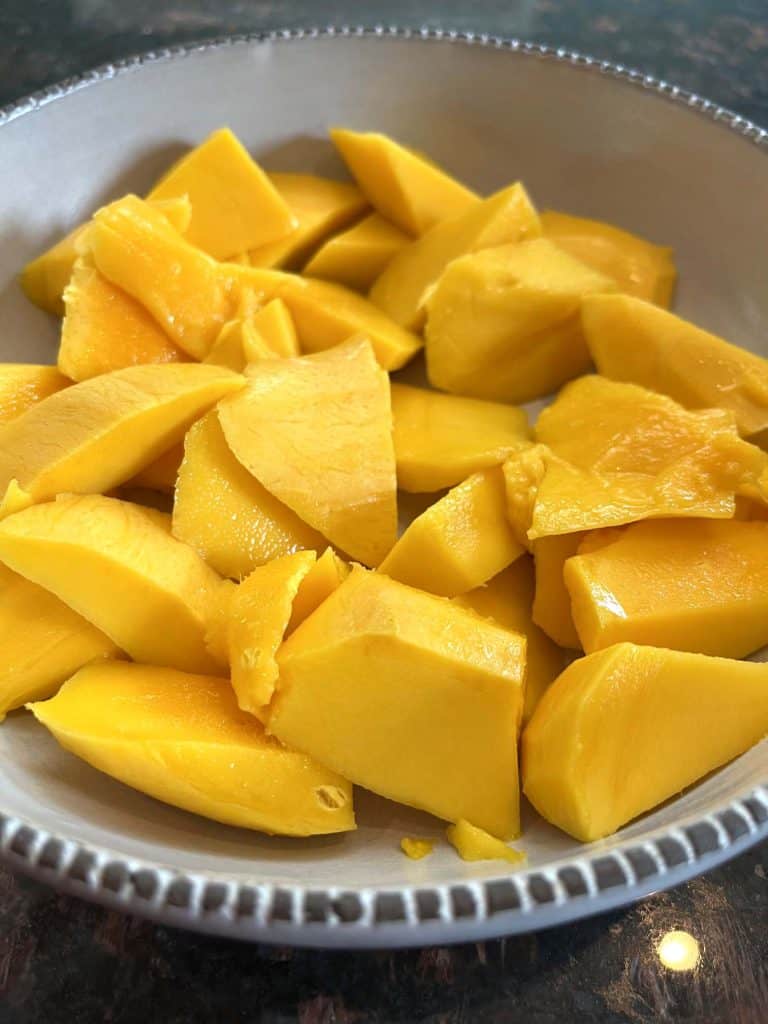

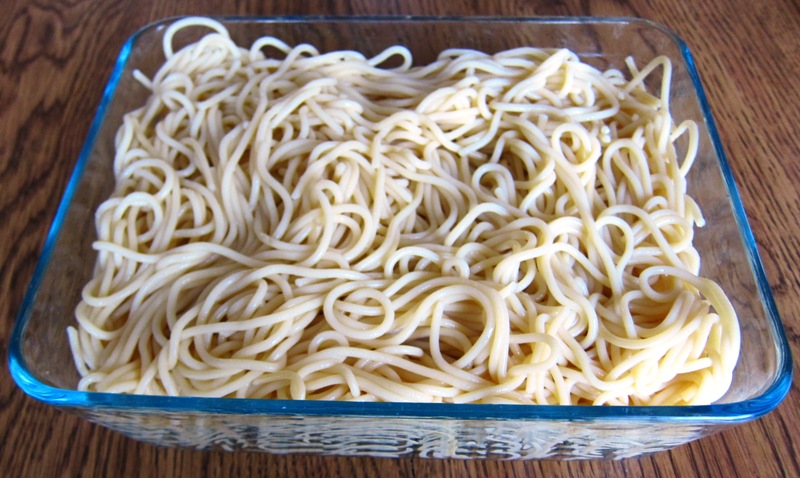
Great advice on knife maintenance and hygiene.